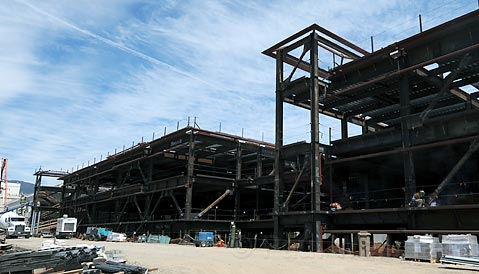Cottage Hospital Two-Step
Wrecking Crews and Traffic Struggles Loom Large

Anticipating the imminent arrival of wrecking crews within the next several weeks, a few hundred people — doctors, nurses, janitors, former patients, and a few neighbors — gathered last Saturday at the remains of St. Francis Hospital, closed since 2003, to bid a fond and final farewell to a venerable Santa Barbara institution where untold thousands came into this world, untold thousands left it, and even more received medical treatment in between. Doctors told old war stories, while others recalled days long gone when nurses still wore hats, nuns scurried about, and chimes rang over the hospital’s public address system every time a baby was born. “The bricks and mortar may be gone,” said Dr. Angel Iscovich, “but the spirit of St. Francis lives on.” That spirit, he said, has been to care for the “poor, the needy, the vulnerable, and the underserved.”
It will fall to the St. Francis Foundation to continue that mission, and Saturday’s event was designed to remind the community that even with St. Francis demolished, the Foundation is still very much in business. Last year, for example, the Foundation — operating with an endowment of about $20 million — gave away $1.2 million, providing medical attention via the Cottage Care Nursing Outreach to 14,000 individuals. Started by the Franciscan Sisters of the Sacred Heart in 1908, St. Francis long shared center stage with Cottage Hospital as one of Santa Barbara’s preeminent health care providers. With the advent of managed care in the late 1980s, St. Francis found itself struggling to stay afloat. It was subsumed into a chain of Catholic-owned hospitals; it won approval to open an annex of new medical offices; nothing worked.

In 2003, St. Francis closed its doors, and shortly thereafter Cottage Health Systems bought the property. After the two months it will take to knock down and haul away the existing structures, Cottage will begin building 115 new homes on the site, 81 of which have been priced below market and set aside for Cottage employees. The $45-million construction project is expected to last two years. During that time, Garden Street will become a nonstop procession of large trucks moving to and from the site. Neighborhood activists are in full alert to ensure that the terms and conditions of the city’s approval are strictly complied with. Currently, they’re questioning whether existing plans adequately address the neighborhood’s unique drainage problems, spawned by a network of underground creeks.
In the meantime, Santa Barbara Mayor Helene Schneider is lobbying hard to get the Santa Barbara County Association of Governments (SBCAG) to approve a study of traffic improvements to the Mission Street and Las Positas Road interchanges at Highway 101 needed to mitigate the impacts of traffic generated by the seismically retrofitted and redesigned Cottage Hospital. Those traffic impacts were deemed an unavoidable Class I negative impact — potentially fatal to any development — forcing the City Council to make findings of overriding consideration to approve the $700-million hospital redesign. Without SBCAG’s approval, City Hall would be effectively barred from seeking state or federal funds needed to complete the $17 million road improvements.
But SBCAG staff has objected that such a study could directly and indirectly compromise their own ability to fund and to finish other projects, most importantly the freeway-widening project between Milpas Street and the county line. If the freeway-widening project were to be delayed, they warn, its costs would escalate, and motorists would be denied timely congestion relief. If these Cottage-related projects were so important to City Hall, they claim, city officials should have included them in Santa Barbara’s list of projects approved by voters countywide two years ago in the form of Measure A, a sales tax surcharge to fund road improvements and transit projects. City officials counter that Santa Barbara citizens provided the most votes for Measure A — not to mention the most tax dollars — and they don’t want to be told to come back in 30 years. Besides, they insist, they can obtain federal funds that would not be otherwise available for the freeway-widening project, but they need SBCAG’s authorization to obtain a study to proceed.
The matter goes before the SBCAG board Thursday, where authorization of the study is regarded as all but inevitable.



